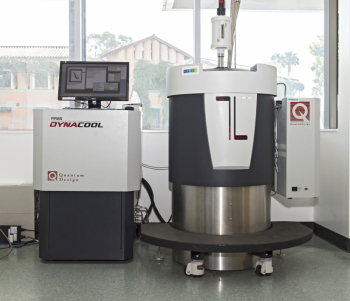
Quantum Design's DynaCool™ PPMS® performs electrical, thermal and magnetic measurements while controlling the samples temperature and magnetic environment.The system uses a single two-stage pulse tube cooler to cool both the superconducting magnet and provide temperature control below 10K, resulting in a low vibration environment for sample measurements. At low temperatures a small amount of Helium-4 is condensed and used to cool the sample while the magnet is cooled through solid contact to a 4 K plate.
Measurements
Samples are mounted and wired to a sample puck which is then placed at the bottom of the narrow sample chamber. The sample puck is keyed to sit in a specific orientation so that each electrical pin enters the correct channel. When a test is performed the instrument will run a current through these channels and the sample while measuring the voltage across it. Some measurement types will require different wire connections between the sample and the puck.
Specifications:
| Temperature Control: | |
|---|---|
| Range: | 1.8 to 400 K @ 60HZ; 1.85 to 400 K @ 50Hz |
| Sample Cool Down Time: | 300 to 1.9 K (stable) in 40 minutes (typical) |
| Magnet Control: | |
| Range & Orientation: | 0 to 9 Tesla, Longitudinal |
| Control Modes: | Linear, Oscillating, No Overshoot |
| Time to Full Field: | Less than 8 minutes (typical) |
| Field Uniformity: | ±0.01% over 3 cm on axis |
| General Details: | |
| Measurement Options: | Resistivity, ETO, Horizontal Rotator & VSM |
| Sample Chamber Size: | Clear bore 2.5 cm (1 inch) diameter |
Electrical Transport Option (ETO)
The ETO option uses a 2-channel measurement system with AC lock-in voltage to measure electrical resistance or Hall effects. Resistance can be measured from 1 µΩ - 10 MΩ using a four wire setup or from 10 MΩ - 5 GΩ using a two wire connection. Its built in functions are (AC) Resistivity, IV Curve, and dV/dI.
Resistivity
The resistivity option is very similar to ETO but has 3 channels, a smaller measurement range (10 µΩ to 1 MΩ) and a lower maximum excitation current (5 mA) but for researchers measuring Hall voltages on irregularly-shaped samples, it is the only option that allows for Van der Pauw wiring.
Horizontal Rotator Option
The Horizonal Rotator option allows samples to be measured at any angle with respect to the magnetic field. It does not do measurements by itself but may be used with either the ETO or resisitivity options.
Thermal Transport Option (TTO)
The Thermal Transport option measures thermal conductivity, Seebeck coefficient, electrical resistivity and the thermoelectric Figure of Merit. Heat loss is measured between two thermometers attached to the sample, following an applied heat pulse and the data is used to determine the thermal conductivity.
If the voltage across the sample is monitored we can report the Seebeck coefficient. The electrical (AC) resistivity is also measured and in combination with the thermal conductivity and Seebeck, the thermoelectric Figure of Merit may be calculated.
Heat Capacity Option (HCO)
In the Heat Capacity option the sample sits on a small platform with an embedded heater and thermometer. Electrical leads connect the platform to the puck and a thermal shield and extra thermometer provide accurate and stable temperature readings.
The sample must be in close contact with the platform as heat is applied to the platform and transferred to the sample. When we stop applying power the puck acts as a heat sink and the time it takes for the sample to relax back down to the puck temperature is used to calculate the heat capacity.
Vibration Sample Magnetometer Option (VSM)
The VSM measures magnetic properties of samples and using a motor (depicted to the right) mounted on top of the sample chamber. While this additional option can measure magnetic properties faster than the SQUID it does so with poorer resolution.
When the VSM motor is attached to the system samples must be mounted in a magnetically neutral tube. During measurements the motor raises and lowers the sample in a linear path.
Related research publications using this instrument
- Enhancing Thermoelectric Properties through Control of Nickel Interstitials and Phase Separation in Heusler/Half-Heusler TiNi 1.1Sn Composites
- Nitrogen surface passivation of the Dirac semimetal Cd3As 2
- Sr3Ir2O7F2: Topochemical conversion of a relativistic Mott state into a spin-orbit driven band insulator
Lab:
Location:
Manufacturer's Info:
The manufacturer's description is posted at http://qdusa.com/products/dynacool.html
Instrument Information and/or Manual:
| Attachment | Size |
|---|---|
| 2.78 MB | |
| 4.54 MB | |
| 439.72 KB | |
| 946.79 KB | |
| 142.49 KB | |
| 157.82 KB | |
| 42.39 KB |
Contact:
To request training or inquire about sending samples please contact amanda [at] mrl [dot] ucsb [dot] edu (Amanda Strom) or seshadri [at] mrl [dot] ucsb [dot] edu (Ram Seshadri).
